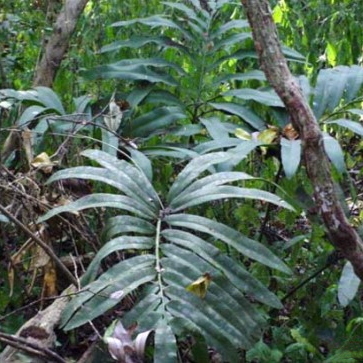Perennial herb with variously carrot-shaped main root or roots continuous with the main stem. Stem subterranean, tuberous, turnip-shaped, up to 10 cm diam., branched or unbranched, with ovate, early deciduous, woolly scales at the apex. Leaves pinnate, 1-4 from the apex of each stem or branch, extremely variable in size (according to ecological conditions), 25 cm-2 m tall, petiolate; petiole more or less equal to the length of the divided blade, grooved on upper side; leaflets in 5-20 pairs, opposite or subopposite, the lowermost shortly stalked, the uppermost connate and decurrent on the rhachis on the lower side, entire or serrulate to irregularly incised-lobate, elongate-lanceolate, acutely acuminate to rounded at apex, up to 40 cm long and 6 cm broad, glabrous. Cones solitary, silvery pubescent becoming brown tomentose, pedunculate. Male cones sub-cylindric, slender, tapered to the apex, 10-15 cm long and up to 3 cm diam., with numerous spirals of scales closely imbricate upwards; scales glabrescent, broadly triangular or rhomboid; bulla face curved upwards with sharp teeth on margin. Female cones elliptic-ovoid, up to 18 cm long, 8 cm diam.; scales stalked; bulla with slightly convex peltate face, imbricate upward, irregularly toothed on margin. Seed red, up to 3.5 cm long, 2.5 cm diam., angled by compression, with fleshy covering adhering firmly to the thin hard inner coat encasing the copious endosperm.
More
Fern-like, perennial, tuberous geophyte. Leaves pinnate, 0.25-2.50 m long, depending on habitat, coriaceous; petioles smooth; leaflets in several to many opposite or subopposite pairs, proximal pairs stalked, distal pairs decurrently fused on rachis, midrib conspicuous with dichotomously forked lateral veins, upper margins serrate. Cones all year; male cones, cylindric, velutinous becoming glabrescent, yellow-brown at maturity; female cones elliptic, velutinous becoming glabrescent, dark green at maturity.


